
"Fiber Broadband" is on everybody's mind right now. But what is fiber broadband? Or just broadband? FOA gets those questions all the time, so we thought it would be good to do a FAQs page - frequently asked questions - on fiber broadband. The FOA also has a page on Resources for Fiber Broadband with links to resources for those interested in building fiber broadband networks. We have also written a book that explains all about fiber broadband and how fiber optics provides the communications we all depend on today. 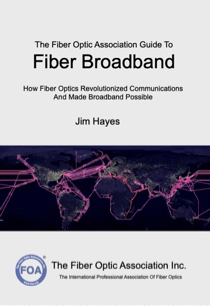 More about The Fiber Optic Association Guide To Fiber Broadband In paperback or Kindle. Order from Amazon or your local bookseller. What is broadband? Broadband is FAST Internet access - fast enough to use for everyday needs like work, school, healthcare, entertainment, shopping, personal connections and dealing with the government or other large organizations. The definition of broadband has changed over the years, starting at 4 megabits/second in 1997 and reaching 1 gigabit/second when fiber to the home was popularized by Google Fiber around 2012. Practically, you need around 100 megabits/second for most of today's applications. "Fiber broadband" means broadband delivered on fiber optics to the home (FTTH.) Fiber has practically unlimited speed for Internet connections. Connect a home with fiber broadband today and it's "future proof." Who needs it? Why? Everybody - for:
How is broadband delivered in the US?
Rank the delivery methods above by bandwidth: 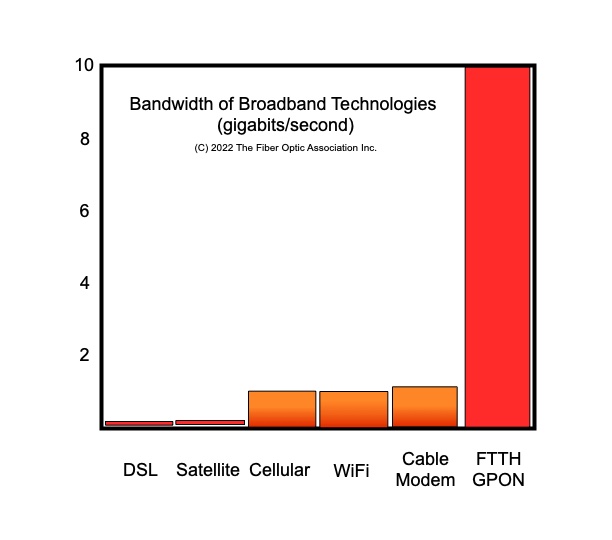 Now you can see why "fiber broadband" is the preferred way to provide broadband. Connect a home with fiber today and it's "future proof." And no, 5G cellular is not comparable to fiber, despite the advertising! Cellular 5G and WiFi 6 are comparable because they use the same transmission protocols, and under ideal conditions can achieve 1 Gb/s. Most FTTH GPON networks in use already provide 2.5 Gb/s down and 1.25 Gb/s up,and some networks have already moved to 10 Gb/s. The federal BEAD funding program states fiber broadband (FTTH) is expected for its future proofing. Who provides broadband?
Broadband began in 1997 with CATV and cable modems. Telcos
tried to use old phone wires and failed. Those who invested in fiber
optics early have solved the problem. Who provides broadband on fiber optics?
Obstacles to providing fiber broadband
Nobody in the US can say it's the cost anymore - the
federal BEAD funding has a pool of $43.5 billion to make FTTH happen.
Add the required matching funds and we're talking $60billion, probably
enough to connect 30-50 million homes if the money is spent wisely. Now we need legitimate service providers and a competent workforce, which FOA is working on now. Organizations working on fiber broadband projects may find this fiber broadband resource page useful in starting a project and finding funding. |
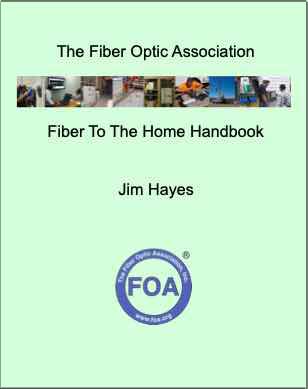 FOA's FTTH Handbook: We've gathered all our information on FTTH from the FOA Guide and past issues of the FOA Newsletter and edited it into a 112 page "FTTH Handbook." We even added new sections on planning, designing and managing FTTH Projects. An entire chapter is devoted to DIY (do-it-yourself) FTTH projects in rural areas. English and Spanish editions. The Fiber Optic Association Fiber To The Home Handbook is available from Amazon in print and Kindle editions. La Asociación de Fibra Óptica Manual de Fibra Hasta el Hogar : Para Planificadores, Gestores, Diseñadores, Instaladores y Operadores De FTTH Amazon  The FOA Guide is FOA's extensive knowledge base on fiber optics, with almost 1,000 pages of technical information. It's written by FOA's worldwide network of technical advisors and is non-commercial, just reliable technical information from experienced fiber techs, many of whom are teaching the subject. Here are some topics related to broadband: FTTH (Fiber To The Home) Fiber
to the home (FTTH) Overview,
FTTH Introduction, FTTH Architectures, FTTH in MDUs, FTTH PON Standards, Specifications and Protocols, FTTH
Network Design
FTTH Installation FTTH Customer Premises Installation FTTH Testing , FTTH Case Studies: Do-It-Yourself FTTH There is also a section on Fiber For Wireless Networks. that covers both cellular and WiFi networks. 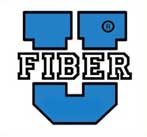 Fiber U is FOA's Free Online Learning Site, with over two dozen free self-study courses starting with the Basics of Fiber Optics and including a number of courses on technical skills and applications of fiber optics. Free Online "FTTH" Course on Fiber U Free Online "Fiber For Wireless" Course on Fiber U 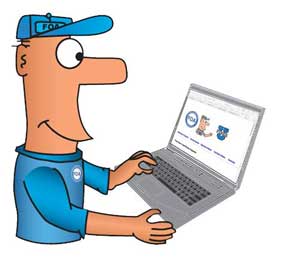 Take the Fiber U FTTH course and Certificate Test FREE Fiber U self-study courses themselves have always been free, but we have charged for the Fiber U Certificate of Completion test which uses an online testing service. So everyone can take advantage of all the new and updated FTTH materials we've created, FOA will offer the testing for the Fiber U Certificate of Completion for the Fiber U FTTx self-study course free to everyone completing the course. Tell your employees, customers, everybody! Designing FTTH Networks? If you are involved in the design of FTTH networks but new to fiber optics, start with the Fiber U Fiber Optic Network Design course then take the Fiber U FTTx self-study course.  FOA Videos On YouTube FOA has a YouTube channel with over 100 videos on fiber optics, including 70+ lectures and many technical instructional videos. Including are these videos on Fiber Optics: FOA's YouTube Channel: Lecture 25: FTTx - Fiber To The Home, Premises, Curb, Business, etc.(Overview) Lecture 70 Rural Broadband- Obstacles and Opportunities
|
Contact the FOA(C) 2022 The Fiber Optic Association Inc. |